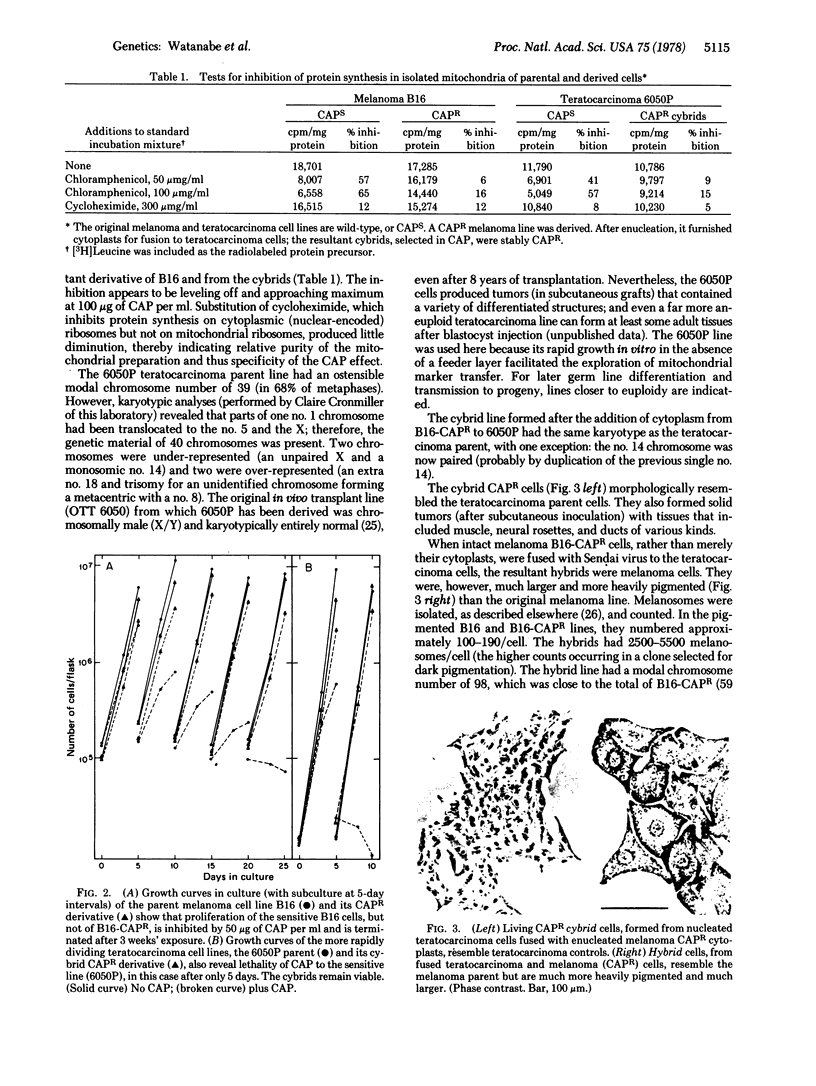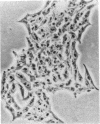Abstract
The immediate purpose of the experiment was to establish a means of introducing specific mitochondrially encoded mutant genes into mice. Mouse teratocarcinoma stem cells were used as vehicles for the cytoplasmic markers because of their known capacity for normal somatic and germinal differentiation after injection into blastocysts. The mutation of choice, chloramphenicol resistance (CAPR), was first produced in a melanoma cell line by mutagenesis and selection. The CAPR trait was then transferred from a resistant melanoma cell to a sensitive (CAPS) teratocarcinoma cell by fusing to the latter only the cytoplasmic portion of the CAPR donor. This indirect route demonstrated the cytoplasmic provenance of the mutation. Protein synthesis in mitochondria isolated from the cybrid, or cytoplasmic hybrid, cells was barely affected by chloramphenicol, in contrast to the inhibitory influence of the drug on mitochondria of the parent teratocarcinoma line. Cells of the cybrid clone resembled teratocarcinoma cells and retained their ability to form diverse tissues in solid tumors produced from subcutaneous grafts. Cells from the tumors were retransplanted and were tested periodically by culture in chloramphenicol; they were found to be stably CAPR even after 16 weeks in vivo in the absence of the selective agent. The CAPR cybrids were microinjected into blastocysts of another inbred strain and, after transfer to foster mothers, mosaic mice were obtained. They comprised both cybrid- and blastocyst-derived cells in various tissues, as indicated by strain-specific nuclear markers. These results demonstrate successful normal differentiation of the CAPR lineage in vivo. Teratocarcinoma cybrids thus offer a practical portal of entry of preselected mitochondrial genes into mice. This will ultimately permit in vivo investigation of maternally transmitted traits, of mitochondrial genetic influences in specialized cells, and of possible roles of cytoplasmic genes in clinical and disease states.
Keywords: chloramphenicol resistance, cytoplasmic inheritance, melanoma, cybrid cells, hybrid cells
Full text
PDF




Images in this article
Selected References
These references are in PubMed. This may not be the complete list of references from this article.
- Attardi B., Cravioto B., Attardi G. Membrane-bound ribosomes in HeLa cells. I. Their proportion to total cell ribosomes and their association with messenger RNA. J Mol Biol. 1969 Aug 28;44(1):47–70. doi: 10.1016/0022-2836(69)90404-5. [DOI] [PubMed] [Google Scholar]
- Borst P. Mitochondrial nucleic acids. Annu Rev Biochem. 1972;41:333–376. doi: 10.1146/annurev.bi.41.070172.002001. [DOI] [PubMed] [Google Scholar]
- Bunn C. L., Wallace D. C., Eisenstadt J. M. Cytoplasmic inheritance of chloramphenicol resistance in mouse tissue culture cells. Proc Natl Acad Sci U S A. 1974 May;71(5):1681–1685. doi: 10.1073/pnas.71.5.1681. [DOI] [PMC free article] [PubMed] [Google Scholar]
- Buzzo K., Fouts D. L., Wolstenholme D. R. EcoRI cleavage site variants of mitochondrial DNA molecules from rats. Proc Natl Acad Sci U S A. 1978 Feb;75(2):909–913. doi: 10.1073/pnas.75.2.909. [DOI] [PMC free article] [PubMed] [Google Scholar]
- Coen D., Deutsch J., Netter P., Petrochilo E., Slonimski P. P. Mitochondrial genetics. I. Methodology and phenomenology. Symp Soc Exp Biol. 1970;24:449–496. [PubMed] [Google Scholar]
- Croce C. M., Koprowski H., Eagle H. Effect of environmental pH on the efficiency of cellular hybridization. Proc Natl Acad Sci U S A. 1972 Jul;69(7):1953–1956. doi: 10.1073/pnas.69.7.1953. [DOI] [PMC free article] [PubMed] [Google Scholar]
- Davidson R. L. Regulation of malanin synthesis in mammalian cells: effect of gene dosage on the expression of differentiation. Proc Natl Acad Sci U S A. 1972 Apr;69(4):951–955. doi: 10.1073/pnas.69.4.951. [DOI] [PMC free article] [PubMed] [Google Scholar]
- Dawid I. B., Blackler A. W. Maternal and cytoplasmic inheritance of mitochondrial DNA in Xenopus. Dev Biol. 1972 Oct;29(2):152–161. doi: 10.1016/0012-1606(72)90052-8. [DOI] [PubMed] [Google Scholar]
- Dewey M. J., Martin D. W., Jr, Martin G. R., Mintz B. Mosaic mice with teratocarcinoma-derived mutant cells deficient in hypoxanthine phosphoribosyltransferase. Proc Natl Acad Sci U S A. 1977 Dec;74(12):5564–5568. doi: 10.1073/pnas.74.12.5564. [DOI] [PMC free article] [PubMed] [Google Scholar]
- Doezema P., Slesinski R. S. Variation in melanosome numbers in cultured B-16 melanoma cells. J Cell Physiol. 1976 Oct;89(2):201–208. doi: 10.1002/jcp.1040890203. [DOI] [PubMed] [Google Scholar]
- Firkin F. C., Linnane A. W. Differential effects of chloramphenicol on the growth and respiration of mammalian cells. Biochem Biophys Res Commun. 1968 Aug 13;32(3):398–402. doi: 10.1016/0006-291x(68)90674-8. [DOI] [PubMed] [Google Scholar]
- Fougère C., Ruiz F., Ephrussi B. Gene dosage dependence of pigment synthesis in melanoma x fibroblast hybrids (hamster cells-mouse fibroblast-DOPA-oxidase-irradiation). Proc Natl Acad Sci U S A. 1972 Feb;69(2):330–334. doi: 10.1073/pnas.69.2.330. [DOI] [PMC free article] [PubMed] [Google Scholar]
- Gearhart J. D., Mintz B. Clonal origins of somites and their muscle derivatives: evidence from allophenic mice. Dev Biol. 1972 Sep;29(1):27–37. doi: 10.1016/0012-1606(72)90040-1. [DOI] [PubMed] [Google Scholar]
- Hutchison C. A., 3rd, Newbold J. E., Potter S. S., Edgell M. H. Maternal inheritance of mammalian mitochondrial DNA. Nature. 1974 Oct 11;251(5475):536–538. doi: 10.1038/251536a0. [DOI] [PubMed] [Google Scholar]
- Illmensee K., Mintz B. Totipotency and normal differentiation of single teratocarcinoma cells cloned by injection into blastocysts. Proc Natl Acad Sci U S A. 1976 Feb;73(2):549–553. doi: 10.1073/pnas.73.2.549. [DOI] [PMC free article] [PubMed] [Google Scholar]
- Kislev N., Spolsky C. M., Eisenstadt J. M. Effect of chloramphenicol on the ultrastructure of mitochondria in sensitive and resistant strains of HeLa. J Cell Biol. 1973 May;57(2):571–579. doi: 10.1083/jcb.57.2.571. [DOI] [PMC free article] [PubMed] [Google Scholar]
- Klinger H. P. Rapid processing of primary embryonic tissues for chromosome banding pattern analysis. Cytogenetics. 1972;11(5):424–435. doi: 10.1159/000130208. [DOI] [PubMed] [Google Scholar]
- LITTLEFIELD J. W. SELECTION OF HYBRIDS FROM MATINGS OF FIBROBLASTS IN VITRO AND THEIR PRESUMED RECOMBINANTS. Science. 1964 Aug 14;145(3633):709–710. doi: 10.1126/science.145.3633.709. [DOI] [PubMed] [Google Scholar]
- Mintz B. Gene expression in neoplasia and differentiation. Harvey Lect. 1978;71:193–246. [PubMed] [Google Scholar]
- Mintz B., Illmensee K. Normal genetically mosaic mice produced from malignant teratocarcinoma cells. Proc Natl Acad Sci U S A. 1975 Sep;72(9):3585–3589. doi: 10.1073/pnas.72.9.3585. [DOI] [PMC free article] [PubMed] [Google Scholar]
- Mitchell C. H., England J. M., Attardi G. Isolation of chloramphenicol-resistant variants from a human cell line. Somatic Cell Genet. 1975 Jul;1(3):215–234. doi: 10.1007/BF01538447. [DOI] [PubMed] [Google Scholar]
- Mounolou J. C., Jakob H., Slonimski P. P. Mitochondrial DNA from yeast "petite" mutants: specific changes in buoyant density corresponding to different cytoplasmic mutations. Biochem Biophys Res Commun. 1966 Jul 20;24(2):218–224. doi: 10.1016/0006-291x(66)90723-6. [DOI] [PubMed] [Google Scholar]
- Seegmiller J. E., Rosenbloom F. M., Kelley W. N. Enzyme defect associated with a sex-linked human neurological disorder and excessive purine synthesis. Science. 1967 Mar 31;155(3770):1682–1684. doi: 10.1126/science.155.3770.1682. [DOI] [PubMed] [Google Scholar]
- Spolsky C. M., Eisenstadt J. M. Chloramphenicol-resistant mutants of human HeLa cells. FEBS Lett. 1972 Sep 15;25(2):319–324. doi: 10.1016/0014-5793(72)80514-3. [DOI] [PubMed] [Google Scholar]
- Stevens L. C. The development of transplantable teratocarcinomas from intratesticular grafts of pre- and postimplantation mouse embryos. Dev Biol. 1970 Mar;21(3):364–382. doi: 10.1016/0012-1606(70)90130-2. [DOI] [PubMed] [Google Scholar]





